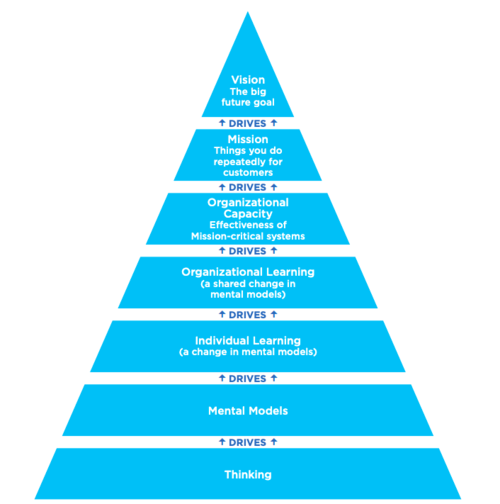VMCL: Difference between revisions
Jump to navigation
Jump to search
(Added def) |
No edit summary |
||
| (3 intermediate revisions by the same user not shown) | |||
| Line 5: | Line 5: | ||
|style="font-size:200%;padding: 10px" | '''V''' | |style="font-size:200%;padding: 10px" | '''V''' | ||
|style="padding: 10px" | '''Vision''' | |style="padding: 10px" | '''Vision''' | ||
| | |Desired future state or goal. | ||
|- | |- | ||
|style="font-size:200%;padding: 10px" |'''M''' | |style="font-size:200%;padding: 10px" |'''M''' | ||
|style="padding: 10px" |'''Mission''' | |style="padding: 10px" |'''Mission''' | ||
|The actions you take, repeatedly, to bring about your vision | |The actions you take, repeatedly, to bring about your vision. | ||
|- | |- | ||
|style="font-size:200%;padding: 10px" |'''C''' | |style="font-size:200%;padding: 10px" |'''C''' | ||
|style="padding: 10px" |'''Capacity''' | |style="padding: 10px" |'''Capacity''' | ||
|The systems that provide readiness to execute mission | |The systems that provide readiness to execute mission. | ||
|- | |- | ||
|style="font-size:200%;padding: 10px" |'''L''' | |style="font-size:200%;padding: 10px" |'''L''' | ||
|style="padding: 10px" |'''Learning''' | |style="padding: 10px" |'''Learning''' | ||
|Continuous | |Continuous improvement of systems of capacity based on feedback from the external environment. | ||
|} | |} | ||
The diagram exemplifies how thinking drives Individual and Organizational Learning, which drives Capacity, which drives Mission, which brings about Vision. | |||
[[File:VMCL_Diagram.png|left|500px]] | |||
https://f.hubspotusercontent20.net/hubfs/7421276/CRL%20Bibliography/AdaptiveLeadershipforAgileOrganizations-1.pdf | |||
==References== | ==References== | ||
Latest revision as of 06:36, 1 February 2023
VMCL Theory is a systems thinking approach to organizational leadership and design developed by Laura and Derek Cabrera.
It is predicated on the idea that four natural organizational functions can be leveraged to optimize emergent outcomes within a system. All organizations are complex adaptive systems characterized by the four inherent functions of vision, mission, capacity, and learning. Each function (or rule) is concisely defined below.
| V | Vision | Desired future state or goal. |
| M | Mission | The actions you take, repeatedly, to bring about your vision. |
| C | Capacity | The systems that provide readiness to execute mission. |
| L | Learning | Continuous improvement of systems of capacity based on feedback from the external environment. |
The diagram exemplifies how thinking drives Individual and Organizational Learning, which drives Capacity, which drives Mission, which brings about Vision.
References
- Cabrera, L., & Cabrera, D. (2022). Adaptive Leadership for Agile Organizations.
- https://blog.cabreraresearch.org/simple-rules-organizations
